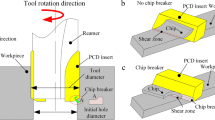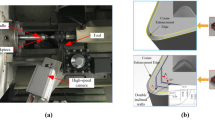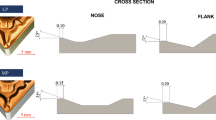Abstract
The 7050 aluminum alloy is becoming more and more popular in aerospace industry, because it has good wear resistance, high strength, and high toughness while having low density. However, due to the small cutting allowance and good plastic, aluminum alloy chips are usually difficult to be broken naturally in high-speed reaming which induced the machined surface scratched. Both the tool structure and matching process parameters are the key ways to solve this problem. Different sizes of chip breaker have been analyzed by FEM simulation. Based on the FEM, three kinds of PCD reamers which have different chip breakers have been compared with the ability of chip breaking in different cutting parameters. It is found that when rotational speed is 288.8 m/min and feed rate per tooth is 0.04 mm/Z with 0.17 mm depth of chip breaker PCD reamer, the best surface quality and lowest cutting force were achieved. It is also found that the cutting force of shallow-breaker-tool (tool B) is the smallest when compared with non-breaker-tool (tool A) and deep-breaker-tool (tool C). The effect of chip breaker size on cutting force, chip curling, and surface roughness has been analyzed in both dry and wet cutting.


















Similar content being viewed by others
Abbreviations
- a p :
-
Cutting depth
- f z :
-
Feed rate per tooth
- D :
-
Diameter of reamer
- γ 0 :
-
Rake angle
- α 0 :
-
Clearance angle
- w c :
-
Width of chip breaker
- R c :
-
Radius of chip breaker
- Kr:
-
Lead angle
- h c :
-
Depth of chip breaker
- n :
-
Rotational speed
- v :
-
Cutting speed
- ψ λ :
-
Chip flow angle
- l f :
-
Chip-tool rake face contact length
- θ :
-
Backflow angle
- Fx :
-
Cutting force of x-axis
- Fy :
-
Cutting force of y-axis
- Fz :
-
Cutting force of z-axis
References
Driemeier L, Brünig M, Micheli G, Alves M (2010) Experiments on stress-triaxiality dependence of material behavior of aluminum alloys. Mech Mater 42(2):207–217
Teimouri R, Amini S, Mohagheghian N (2017) Experimental study and empirical analysis on effect of ultrasonic vibration during rotary turning of aluminum 7075 aerospace alloy. J Manuf Process 26:1–12
Fukui H, Okida J, Omori N, Moriguchi H, Tsuda K (2004) Cutting performance of DLC coated tools in dry machining aluminum alloys. Surf Coat Technol 187(1):70–76
Stoeterau RL, Janssen A, Mallmann G (2016) Analysis of dimple textured surfaces on cutting tools. J Braz Soc Mech Sci Eng
Bian R, He N, Li L, Zhan ZB, Wu Q, Shi ZY (2014) Precision milling of high volume fraction SiCp/Al composites with monocrystalline diamond end mill. Int J Adv Manuf Technol 71(1-4):411–419
Okada M, Asakawa N, Fujita Y, Nikawa M (2014) Cutting characteristics of twist drill having cutting edges for drilling and reaming. J Mech Sci Technol 28(5):1951–1959
Gonçalves RA, da Silva MB, Costa ÉS (2018) Statistical analysis of cutting forces and hole accuracy in reaming an Al–Si–Mg alloy (6351) with different copper contents. J Braz Soc Mech Sci Eng 40(11)
de Oliveira Campos F, Mougo AL, Araujo AC (2016) Study of the cutting forces on micromilling of an aluminum alloy. J Braz Soc Mech Sci Eng 39(4):1–8
Wang B, Liu Z (2016). Investigations on deformation and fracture behavior of workpiece material during high speed machining of 7050-T7451 aluminum alloy. CIRP J Manuf Sci Technol S1755581716300281.
Da Silva L R, da Silva O S, dos Santos F V, Duarte F J, Veloso G V (2019). Wear mechanisms of cutting tools in high-speed turning of Ti6Al4V alloy. Int J Adv Manuf Technol
Bian R, He N, Ding W, Liu S (2017) A study on the tool wear of PCD micro end mills in ductile milling of ZrO2 ceramics. Int J Adv Manuf Technol
Soares RB, de Jesus AMP, Neto RJL, Chirita B, Rosa PAR, Reis A (2017) Comparison between cemented carbide and PCD tools on machinability of a high silicon aluminum alloy. J Mater Eng Perform 26:4638–4657
Katahira K, Matsumoto Y, Komotori J, Yamazaki K (2017). Experimental investigation of machinability and surface quality of sapphire machined with polycrystalline diamond micro-milling tool. Int J Adv Manuf Technol
Gao Y, Huang K, Yang W (2020) Analytical model of cutting temperature field in workpiece including uncut chip layer. Int J Adv Manuf Technol 107(9-10):3943–3952
Pacella M (2019) A new low-feed chip breaking tool and its effect on chip morphology. Int J Adv Manuf Technol
Lotfi M, Akhavan Farid A, Soleimanimehr H (2014) The effect of chip breaker geometry on chip shape, bending moment, and cutting force: FE analysis and experimental study. Int J Adv Manuf Technol 78(5-8):917–925
Liu EL, Han RD, Tan GY, Li ZJ (2006) Analysis of chip breaking prediction in cutting aluminum alloys. Mater Sci Forum 532-533:213–216
Gonzalo O, Quintana I, Etxarri J (2011) FEM based design of a chip breaker for the machining with PCD tools. Adv Mater Res 223:133–141
Fang N, Pai PS, Mosquea S (2010) The effect of built-up edge on the cutting vibrations in machining 2024-T351 aluminum alloy. Int J Adv Manuf Technol 49(1-4):63–71
Buchkremer S, Klocke F, Veselovac D (2015) 3D FEM simulation of chip breakage in metal cutting. Int J Adv Manuf Technol 82(1-4):645–661
Iwata K, Osakada K, Terasaka Y (1984) Process modeling of orthogonal cutting by the rigid-plastic finite element method. J Eng Mater Technol 106(2):132–138
Tabei A, Shih DS, Garmestani H, Liang SY (2016) Dynamic recrystallization of Al alloy 7075 in turning, ASME J. Manuf Sci Eng 138(7):071010 (7 pages)
Taylor FW (1907) On the art of cutting metals. Trans ASME 1119:31–58
Wang Y, Yang X, Xu Q (2017) Study on cutting force and hole quality of PCD step reamer for reaming ZL102 alloy in dry and wet conditions. Int J Adv Manuf Technol 90(5-8):1693–1702
Coppini NL, Diniz AE, Lacerda FS, Bonandi M, Baptista EA (2018) Internal turning of sintered carbide parts: tool wear and surface roughness evaluation. J Braz Soc Mech Sci Eng 40(4):216
Xiuli F, Wenxing L, Yongzhi P, Wentao L (2017) Morphology evolution and micro-mechanism of chip formation during high-speed machining. Int J Adv Manuf Technol 98(1-4):165–175
Fatima A, Mativenga PT (2013) A review of tool–chip contact length models in machining and future direction for improvement. Proc Inst Mech Eng B J Eng Manuf 227(3):345–356
Author information
Authors and Affiliations
Corresponding author
Additional information
Publisher’s note
Springer Nature remains neutral with regard to jurisdictional claims in published maps and institutional affiliations.
Rights and permissions
About this article
Cite this article
Yu, X., Wang, Y. & Lv, D. A novel chip breaker structure of PCD tool for the reaming of 7050 aluminum alloy. Int J Adv Manuf Technol 109, 659–672 (2020). https://doi.org/10.1007/s00170-020-05658-3
Received:
Accepted:
Published:
Issue Date:
DOI: https://doi.org/10.1007/s00170-020-05658-3




